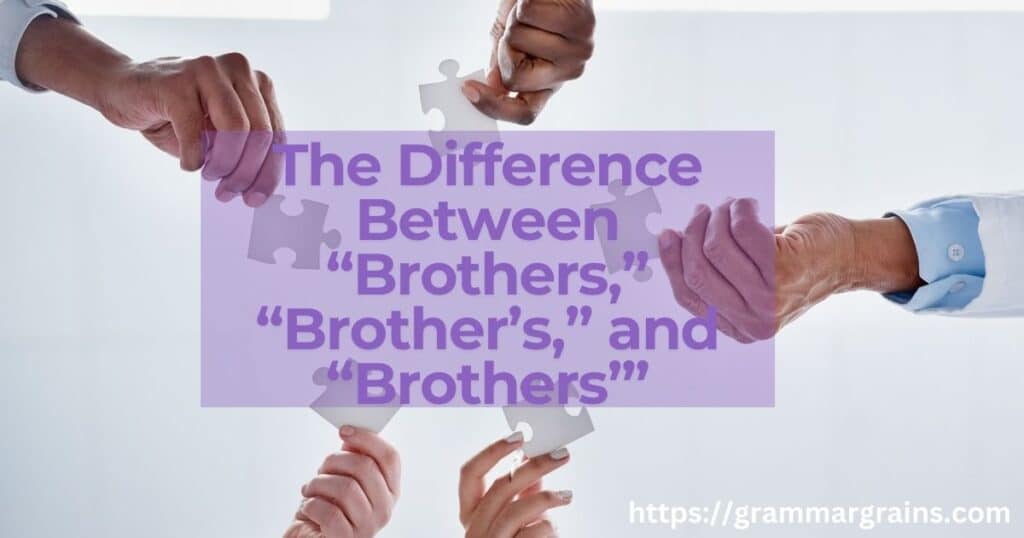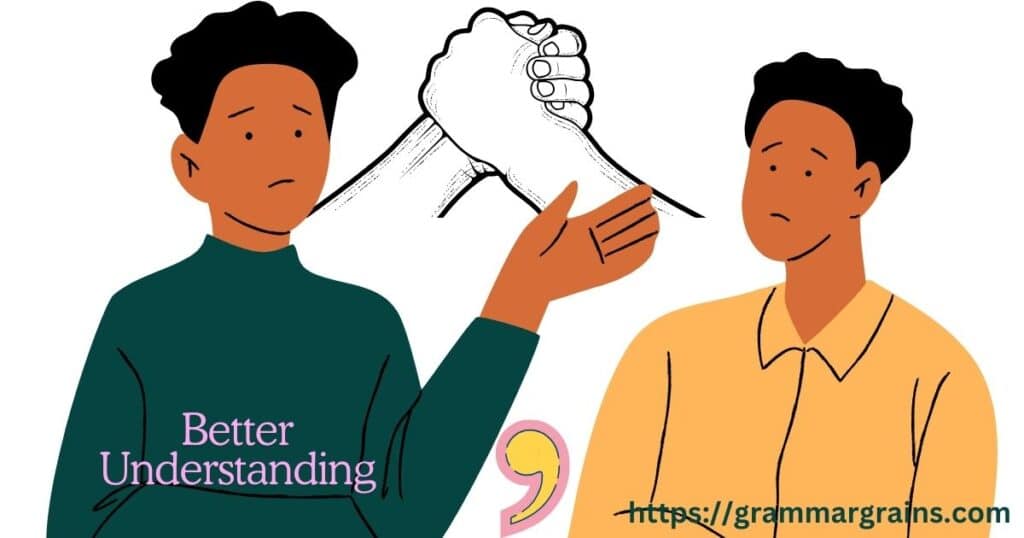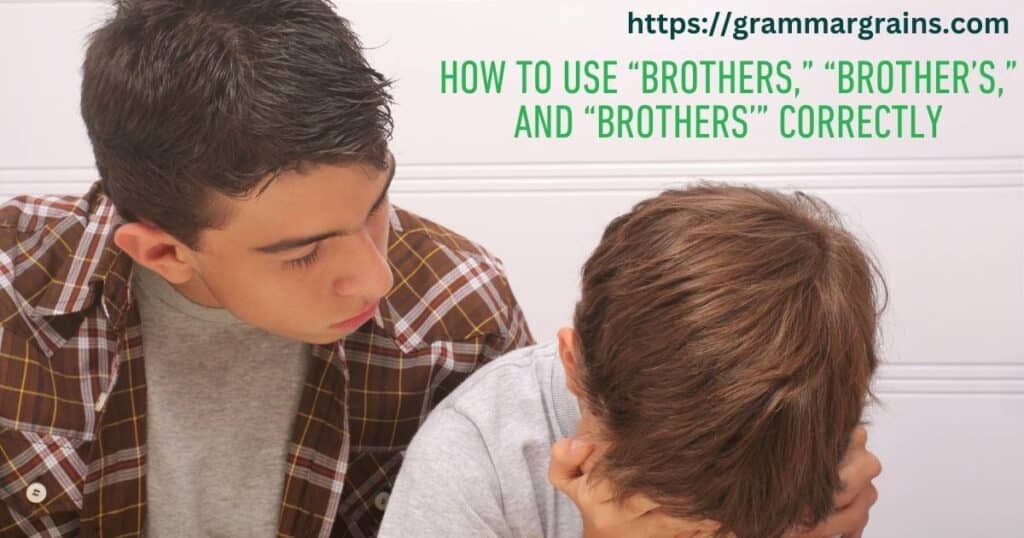Understanding the difference between “brothers”, “brother’s”, and “brothers’” is crucial for clear and effective communication. These terms may seem similar, but a misplaced apostrophe can drastically alter the meaning of a sentence.
Have you ever wondered how a small punctuation mark like an apostrophe holds so much power?
This guide will uncover these nuances and equip you with the skills to use them correctly, every time.
Importance of Clarity in Communication
Clear communication depends on using grammar accurately.
When you misuse possessive forms, it confuses readers and distorts your message.
For instance, saying, “My brother’s car is red,” indicates that one brother owns the car.
However, if you write, “My brothers’ car is red,” it implies ownership by more than one brother.
These distinctions might seem minor, but they carry significant meaning.
In everyday conversations, misunderstandings happen when people misplace apostrophes.
For example, if someone writes, “The brother’s are arriving,” they create confusion by wrongly combining a plural form and a possessive form.
The correct sentence should read, “The brothers are arriving.”
These errors highlight why understanding possessive rules is crucial for clear communication.
Missteps often appear in professional settings too, where precision matters even more.
When you draft a report or email, a small grammatical error can reflect poorly on your writing abilities.
Understanding the Basics

The Difference Between “Brothers,” “Brother’s,” and “Brothers’”
The differences between “brothers,” “brother’s,” and “brothers’” stem from grammar rules involving plural forms and possessive forms.
“Brothers” is the plural form of “brother”, meaning you are referring to more than one male sibling.
For example, you might say,
“I have two brothers.”
When you add an apostrophe and an “s,” as in “brother’s,” it shows singular possession.
This means something belongs to one brother.
A proper sentence example would be, “My brother’s jacket is on the couch.”
Adding the apostrophe after the “s,” as in “brothers’,” changes it to plural possession.
It now implies that something belongs to more than one brother.
For instance, “The brothers’ room is upstairs” clearly indicates ownership by multiple brothers.
Understanding these differences eliminates guesswork and ensures your sentences convey the right meaning.
Grammar Essentials

The Apostrophe and Possession
The apostrophe is a small but powerful tool in the English language.
It determines ownership and makes your writing precise.
In singular possession, the apostrophe goes before the “s,” as in “brother’s.”
This rule applies when one brother owns something, like in the sentence, “My brother’s shoes are muddy.”
Without the apostrophe, the meaning changes entirely and no longer reflects possession.
When dealing with plural possession, the apostrophe follows the “s.” For example, in “My brothers’ bikes are outside,” the apostrophe after “s” shows that the bikes belong to multiple brothers. Writers often confuse this placement, which creates unnecessary errors. You must also remember that if the word is already plural without adding “s” (like “children”), the apostrophe comes before the “s” for possession. This nuanced rule ensures accurate grammar and proper ownership representation.
Usage Examples

Examples for Better Understanding
Using correct forms depends on knowing the difference between plural forms and possessive forms.
For example, consider these sentences for each: “Brothers”, the plural form, works in sentences like, “My brothers are at the park.”
This sentence simply indicates more than one brother.
When using “brother’s,” it reflects singular possession.
For instance, “This is my brother’s laptop” means the laptop belongs to one brother.
Similarly, when you write “brothers’,” it implies plural possession.
An example would be, “The brothers’ shared bedroom is clean.”
This sentence means that the bedroom belongs to all the brothers.
These differences might seem trivial, but they greatly affect sentence clarity.
By practicing with examples, you can master these forms and use them effectively in both spoken and written communication.
Consider this sentence: “My brother’s advice helped me succeed.” It shows possession and highlights a singular brother offering guidance. Compare that to, “My brothers’ support keeps me strong,” where the apostrophe placement clearly shows the contribution of multiple brothers.
Practical Scenarios

How to Use “Brothers,” “Brother’s,” and “Brothers’” Correctly
In real-world situations, understanding the proper use of “brothers,” “brother’s,” and “brothers’” can avoid miscommunication.
Imagine writing a family group text to your siblings.
Saying, “My brothers are visiting this weekend,” indicates you are referring to all your brothers collectively.
However, if you text, “My brother’s coming to help me,” you mean only one brother plans to assist.
Professional settings also require precision.
Consider this sentence in an email: “The brothers’ construction company built the new office.”
This usage clearly communicates that the company is owned by multiple brothers.
Misplacing the apostrophe here would confuse the recipient about the ownership or focus of the sentence.
In both casual and formal writing, correct usage ensures your message remains clear and free of ambiguity.
Avoiding Common Errors
Many writers confuse plural forms with possessive forms due to similar spellings.
For example, people might write, “The brother’s are coming over,” which incorrectly combines plural and possessive forms.
The correct sentence is, “The brothers are coming over.”
Similarly, omitting the apostrophe in a sentence like, “My brothers dog ran away,” misses the possessive form.
The corrected version would be, “My brother’s dog ran away.”
Another frequent error involves apostrophe placement. Writing, “The brothers bike is in the shed,” creates confusion because it lacks proper possession. It should be, “The brother’s bike is in the shed” for one brother, or “The brothers’ bikes are in the shed” for more than one. By understanding these distinctions and applying them regularly, you can eliminate these errors from your writing.
Advanced Insights: Special Cases and Examples
Special cases often arise in writing when you deal with joint possession or separate ownership.
When two people jointly own something, you only need to use an apostrophe with the second noun.
For example, “Emma and Sarah’s project was successful” implies that both Emma and Sarah worked on the same project.
However, if they worked on separate projects, you would write, “Emma’s and Sarah’s projects were successful.”
This distinction is critical for clarity in both personal and professional communication.
Similarly, family dynamics can lead to more nuanced scenarios.
Imagine describing a shared family heirloom, such as a house passed down to multiple brothers. You would write, “The brothers’ house has been in the family for generations.”
Here, the apostrophe placement clearly indicates that the house is owned collectively by all the brothers.
If only one brother owned it, the sentence would change to, “The brother’s house has been in the family for generations.”
Understanding such cases ensures that your message is both precise and easily understood by your audience.
Cultural Considerations
Cultural differences also influence how people use possessive forms in the English language.
For instance, British English and American English share similar apostrophe rules but differ in their use of certain expressions.
In British English, it is common to hear phrases like, “The brothers’ cricket bats were left outside,” while American English might replace “cricket bats” with “baseball bats.”
This variation highlights the importance of context and cultural relevance when writing for a specific audience.
Moreover, some languages, such as Chinese or Japanese, do not use possessive apostrophes in the same way as English.
This can create challenges for non-native speakers learning the language.
A common error for learners might be writing,
“The house of my brothers,”
instead of the correct form,
“My brothers’ house.”
Teaching these nuances with real-world examples helps bridge cultural gaps and fosters better understanding of English grammar.
Practical Tips and Tools

Mastery Tips for Perfect Usage
To master possessive forms, practice is essential.
Start by writing sentences that involve ownership.
For example, describe family relationships using possessive forms:
“My father’s advice is invaluable,”
or
“The sisters’ voices filled the room.”
Rewriting these sentences with incorrect apostrophe usage can also help identify common errors and reinforce the rules.
Using tools like grammar checkers can further enhance your writing.
Online platforms like Grammarly and ProWritingAid can detect misplaced apostrophes and suggest corrections.
These tools are particularly useful for students, professionals, and non-native speakers.
Additionally, creating flashcards with examples such as
“The brother’s car” (singular possession) and
“The brothers’ cars” (plural possession)
can help solidify these rules.
Teaching and Learning Applications
Teaching apostrophe rules can be engaging with interactive exercises.
For example, ask students to identify errors in sentences like, “The brothers’ is coming over,” or rewrite sentences such as, “The sisters shoes are lost,” to their correct forms.
Digital resources like Kahoot or Quizlet allow educators to gamify grammar lessons, making the process enjoyable and memorable.
In a classroom setting, group activities involving real-life scenarios can also be effective.
Divide students into teams and provide prompts such as,
“Write an email about a family dinner,”
ensuring they correctly use brothers, brother’s, or brothers’ based on the context.
These practical applications help learners apply grammar rules confidently in everyday writing.
Personal Communication
In personal communication, whether it’s texting, emailing, or writing letters, correctly using brothers, brother’s, and brothers’ avoids misunderstandings.
For instance, writing, “My brother’s coming over for dinner,” instantly clarifies that one brother is visiting.
In contrast, “My brothers are coming over,” involves all your siblings.
Small errors in such contexts can lead to unnecessary confusion, especially when organizing family events or sharing important updates.
Social media is another area where grammar accuracy matters. Imagine posting, “The brother’s soccer match was great,” when you meant to refer to multiple brothers. Such mistakes can distract your audience or even become meme-worthy errors. Taking the time to double-check apostrophe usage ensures your message is professional and clear, even in casual conversations.
Professional Writing
In professional settings, mastering possessive forms is non-negotiable.
Legal documents, business reports, and academic papers require precision.
For example, writing,
“The brothers’ construction company won the contract,”
signals collective ownership.
However, if the apostrophe is misplaced, as in,
“The brother’s construction company won the contract,”
it could mislead readers into thinking only one brother owns the company.
Creative writing also benefits from proper grammar. Consider a narrative describing two siblings. Writing, “The brothers’ adventure in the woods was thrilling,” paints a clear picture of shared experiences. Misusing the apostrophe here could muddle the story. By consistently applying these rules, writers can enhance their storytelling and maintain clarity.
Conclusion
Understanding and applying the rules for brothers, brother’s, and brothers’ enhances both personal and professional communication. Whether you’re writing about family dynamics, drafting a business report, or telling a story, getting the grammar right ensures your message is clear. The English language relies heavily on these distinctions to convey meaning effectively.
Practice with real-world scenarios, use grammar tools for accuracy, and continuously refine your skills. As Emma once said in a family group text, “My brothers’ support means everything to me,” the proper use of plural possessive perfectly conveyed her sentiment. Let’s aim to communicate with the same clarity and precision in all our writing.
FAQs
Q1: How do I know where to place the apostrophe?
Place it before “s” for singular possession and after “s” for plural possession.
Q2: Can “brothers” ever need an apostrophe?
Yes, when showing ownership, it becomes brother’s or brothers’ depending on the context.
Q3: Why is the difference between “brothers” and “brother’s” important?
It ensures clarity in both written and spoken communication.
Q8: How can I practice using these forms?
Write sentences or use online grammar tools to test your understanding.
Q9: What’s a common mistake with these terms?
Confusing plural forms with possessive ones, like writing “brother’s” instead of “brothers.”

Taila Lucy, an expert content writer at Grammar Grains, brings 4 years of experience crafting engaging pieces on grammar. Her work delves into synonyms, antonyms, slang, puns, and poetry, helping readers master English with creativity and flair.






